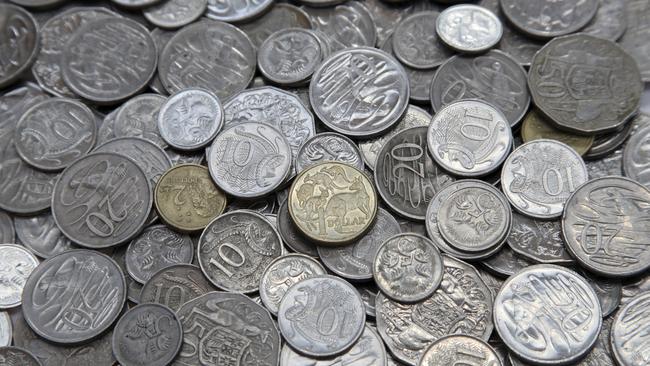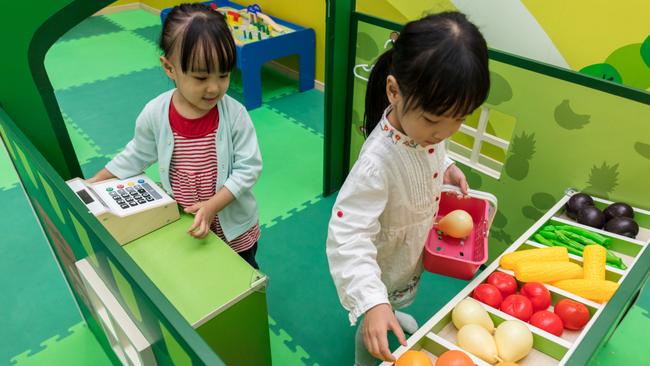Easy ways to teach your kids how to save
Despite our cashless tap-and-go society, teaching children about saving is as important as ever, says TV host, finance guru and father of four David Koch. Here’s how to teach your kids about money at any age.

Business
Don't miss out on the headlines from Business. Followed categories will be added to My News.
Parents usually think saving is the first lesson, but it only forms part of the big picture of managing money.
Learning how to spend properly is as important as learning how to save.
For the record, according to the most recent research, 80 per cent of parents give their children pocket money.
For four to 10-year-olds, the average amount is $7-$8 a week, for 10-12-year-olds $12, and for 13-15-year-olds $15. So the stats show we’re generally using the $1 per year of age method.
Inspire and coax your child into saving for the things they want.
READ MORE:
BAREFOOT: KIDS MUST EARN POCKET MONEY
INVISIBLE CASH MAKES IT HARD TO TEACH KIDS
THREE MINUTE MONEY HACK FOR KIDS

Start teaching as early as possible. Managing money is a skill just like riding a bike or making the beds, so don’t make it any more scary or boring than these activities.
Start by explaining what saving is: putting something away in a safe place to be used when needed at another time. Inevitably your child will ask why. Explain that there are three basic reasons to save money: to buy something we want at a later date when we have enough money, for protection against an emergency and for retirement.
Younger children aren’t interested in the last two but they’re worth mentioning to teenagers and young adults. The key is to emphasise the first reason and use examples that will appeal to them.
The next time you take your child shopping, let them choose an item and set them a goal of buying it for themselves. Even though they may find the amount of money daunting, explain that by saving regularly they’ll soon have the required amount. In this way, parents can help their children learn to save by emphasising the fun of saving money.
Children, like adults, feel a great sense of satisfaction from being able to use their own money to buy something. It makes them feel grown up and independent.

Don’t rely on your child’s self-discipline at this early stage, as it often fails.
It’s important to give them your support. Take an interest and make it a cooperative effort. Maybe match their savings with a contribution from you as they pass certain milestones. Reaching halfway to a savings goal, for example, should be a reason to celebrate and to remind your child that they’re on the home stretch.
The key to saving is regularity, so set aside a particular time each week when you and your child deposit money into a piggy bank or a bank account.
Buy them a fun moneybox and make sure it stays in a safe and accessible part of the house. Putting a picture of their savings goal on the money box can also be an incentive.
Saving is simply collecting money — there should be no mystique attached to it. So encouraging stamp, marbles or sports-card collecting can be a fun way to teach the notion of saving.
Use the example of the swap market, where the number of cards in a collection have a value (just like money), but the value changes with respect to their individual worth (like money).

AGES TWO TO FOUR
It’s never too early to teach children about money. For the very young it’s a case of explaining what money is and making them familiar with the various shapes and sizes
of coins.
To a very small child, big means more, and the fact that the 50-cent coin is three times larger than the $2 coin can be confusing.
Explain the different types of coins and use the tails pictures to make them interesting.
For example, show them the kangaroos on the $1 coin and the Aboriginal man on the $2, and build stories around them.
At this early age, playing games can be an effective way to teach an understanding of what money is and what it looks like.
Draw circles around the coins on a piece of paper and ask the child to match the coins to their circles. It’s similar to fitting shapes into holes and a good way to teach them that small coins don’t equal low value. Call out a particular coin and see if your child can select the right one to fit into the right circle.
Be careful to ensure that money itself isn’t treated like a game.
Children at this age should be told that money is important and they need to look after it. They must also learn not to help themselves to anyone else’s money.

AGES FIVE TO SIX
At this age, children are old enough to save regularly with a piggy bank.
Get them to feel how much heavier it gets the more they save. We’ve found that a clear perspex piggy bank can provide a child at this age with a sense of achievement because they can literally see the coins build up.
It’s also an appropriate age to start teaching children about the value of notes.
It often seems strange to children that something as flimsy as our polymer notes can be worth so much, especially when it looks like the paper they use for drawing and colouring. Use the stories behind the famous people on the notes to make them interesting.
This is also the time to start giving them pocket money for a small household job performed regularly.
The small change game is a good one for this age group. The aim of the game is to collect all the small change in the house and make as many different piles of coins as possible to equal one dollar. Its purpose is to make children realise how coins relate to each other. When all the money is stacked up, emphasise how much a dollar is worth.

AGES SEVEN TO 12
Now’s the time to open a savings account for your child.
Choose a children’s account that has newsletters and a special club for the kids to join. We’ve been very impressed with the creativity and information offered by a number of accounts. Make sure you spend time with your child reading through the information
and helping them understand what’s available to them.
Now that they know why saving is important, you’ll need to explain why we put our money into a bank, credit union or other financial institution.
Here’s a suggested explanation: A bank is a safe place to keep your money. The bank uses that money to lend to other people, and as a reward for you keeping that money at the bank, it pays you interest.
One of the most valuable activities in learning the money game is “playing shops”.
Every child loves being the shopkeeper or dressing up and being the customer.
One of our longest-lasting toys is a cash register with fake money. It’s offered hours of amusement for all our four children and now our grandchildren. This role-playing is an important part of a child’s early financial development.
In this age group, children start to shop for themselves, so they need to know how to pay and receive change.
Set up a shop counter
at home with the aim of showing children how to work out what change they should receive. Take turns being the shopper so the child sees both sides of money at work.

AGES 13-PLUS
This is a critical age. Teenagers are targeted by marketers because they are seen to have a large amount of disposable income.
It’s also the time when they’re at their most vulnerable to peer pressure and to the lure of expensive fads to stay “cool”.
It’s difficult for them to comprehend the cost of brand-name clothing and sneakers, and the pressure to have them is immense.
This is also the time when entertainment expenses start to grow as kids begin to form relationships. Movies, music and mobile phones are a fact of life for teenagers. All these things place more pressure on funds, and the savings goals become bigger.
Inevitably, parents are courted for more pocket money, and part-time jobs loom.
At this point, consider giving your teenager management of their own money, particularly when they begin a part-time job. But remain active in their financial affairs so you can keep an eye on them.
Edited extract from Kochie’s 11-step money plan for a better life (MacMillan Australia,
RRP $30), out on Tuesday.
Originally published as Easy ways to teach your kids how to save


